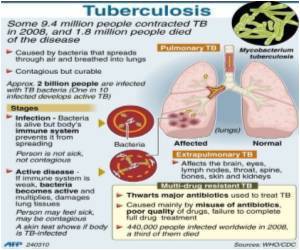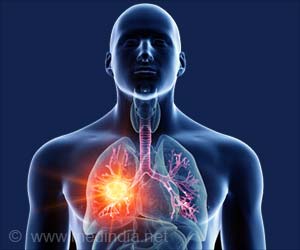Sincere community involvement at all stages is thus crucial in the fight against tuberculosis (TB).

TB is the leading cause of death among people living with HIV; and nearly one third of all reported cases are TB/HIV co-infection. TB accounts for almost 20% of all deaths and 26% of all preventable deaths in the age group of 15 to 49 years –the most economically productive age group.
Africa has a very disproportionate burden of TB. It is home to 12% of the world’s population but 30% of the world’s burden of TB. 9 of the 22 high burden countries are situated in Africa alone.
Sincere community involvement at all stages is thus crucial in the fight against this deadly disease-- right from the development of new treatments to making them available to those in need of them.
The impact of TB is not confined to the patient alone; illness of an adult can affect the quality of children's lives as well. TB contributes to the socioeconomic deprivation of families and communities, resulting in increased poverty and persistent hopelessness. Weak health systems and inadequate resources are compounding the problem and necessitating community based programmes to tackle the issue.
According to Dr Jeremiah Chakaya, Chair of the Stop TB Partnership's DOTS Expansion Working Group, community participation is at the core of the success of the TB DOTS programme. Health personnel need the help of community care givers in ensuring that the patient does not default from the regimen of completing the full six-month course of treatment, typically involving four drugs. Else, patients might develop drug resistant TB, and in turn create a significantly large pool of infected people.
Advertisement
To slow down infection rates, several Southern African countries have now launched community-based screening, treatment and care programmes, especially in areas where access to health education and care is limited.
Advertisement
It is essential to:
(i) Educate communities about TB disease, treatment and the research process.
(ii) Understand community perceptions and identify community concerns so that they are addressed in the research process.
(iii) Liaise with community stakeholders to facilitate smooth implementation of clinical programs.
(iv) Motivate communities to assist with program/policy change.
Dr Hind Satti, Clinical Director, Partners In Health, Lesotho, talked about the success story of the Community based treatment model operative in all the 10 districts of Lesotho since 2007. Lesotho has a population of 1.8 million, where 12,275 new cases of TB were notified in 2009. It has a very high prevalence rate of HIV, with 80% of all TB patients being HIV positive.
Adherence to the treatment regimen is crucial to success of TB cure. But there are many barriers to this adherence, chiefly in the form of socioeconomic obstacles. The Lesotho model has addressed these barriers successfully by means of community mobilisation. Currently around 550 patients are enrolled in the community based treatment programme. The treatment supporters come from the community and form a rapport with the affected family. They accompany the patient to all clinical visits, and also provide psychosocial support to the patient and his/her family. They are trained by the local healthcare centre to observe all drug doses, report any side effects, administer injections, and screen for HIV/TB infections in household contacts.
Dr Satti feels that "Diagnosis and management of all types of TB, including MDR-TB in high HIV prevalence settings is challenging but possible with the help of community - for rapid enrolment and close monitoring of side effects."
Community activist, Nelson Otwama, from Kenya, also believes that the community can help in a big way by educating about the disease, treatment, cough etiquette, reduction of stigma and isolation, resource mobilization and advocacy to support the adoption of new MDR regimens by national TB authorities.
Another advocacy manager and patient representative, Francis Apina said that community input is a critical component of the research process. It is actually stigma, isolation and quarantine versus community based care. Inadequate patient information and education, social barriers and stigma - all add to the challenges with the current treatment regimens which is increasing MDR-TB.
Francis feels that "current TB drug regimen is inadequate and presents many challenges of treatment; such as pill burden, length of treatment, incompatibility with ARV, non-compliance, the emergence of MDR and XDR-TB. Current treatment is still inadequate to address the challenges of TB/HIV and drug-resistant TB. New tools to quickly diagnose and more effectively treat and prevent TB are desperately needed."
Hence we need community advocates to talk about clinical trials to the voluntary study groups; community mobilizers to help clinical trials to succeed; community educators to urge people living in infected areas to go for TB/HIV screening; and community care givers to help the patients to strictly follow the treatment regimen and not lose hope, despite all odds.
Only then will the Critical Path To TB Drug Regimens (CPTR) will make an impact by accelerating the development and delivery of new and improved TB treatment regimens, and by sharing data among the CPTR partners promotes an efficient development model that puts patient needs first. New treatments should not become the privilege of a select few, but should be made available to all those in need.
Contributed by: Bobby Ramakant
Source-Medindia









